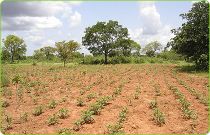The IUCN releases a reforestation map
The IUCN has released a map, the first of its kind, which illustrates where groups can start reforestation projects.

The International Union for Conservation of Nature (IUCN) has released a map, the first of its kind, which illustrates where groups can start reforestation projects.
The map is part of preliminary analysis which shows that 1.5 billion hectares of global forest could be restored comparable to a space the size of Russia. This is the result of the latest global research, which now needs to be expanded at a national level to identify specific on the ground opportunities, says the ICUN.
The research was produced by The Global Partnership on Forest Landscape (GPFLR), WRI, South Dakota State University and the IUCN. The most important factor of the map is that it shows how global forests have great potential for recovery and where forests can be regained.
Stewart Maginnis, Director of Environment and Development at IUCN said: "Until recently scant attention has been paid to the world's degraded forests.
"Now is the time to recognise the potential of restored forests to deliver the double benefit of moving CO2 from the atmosphere and helping lift people out of poverty. However, there's no 'one size fits all' solution – each forest landscape is unique and needs its own individual restoration strategy."
The map reveals that the continents with the greatest promise are Africa and Asia, each with 500 million hectares of forest landscaping offering opportunities for forest restoration, according to the IUCN.
The report also states: "The restoration opportunities are typically not located in areas of ongoing deforestation and degradation; they tend to occur where degradation and deforestation have already made their mark."
The report carries on to say that this is not the only solution and not all areas can or should be restored in the same way. The map is a starting point, to encourage people to start reforestation programmes. Each landscape needs a different method and design which can also be fitted to the different needs of the site due to geographical and social changes.
The release of the analysis comes a month before the launch of the UN's International Year of Forests, a global platform to celebrate people's action to sustainably manage the world's forests.
Carole Saint Laurent, IUCN's Senior Forest Policy Advisor said: "Restoring the world's lost and degraded forests is possible. Countries as diverse as China, Ghana, Mexico, India, the United Kingdom, the United States and many others have already embarked on ambitious forest restoration programmes."
Author: Charity Knight | Climate Action
Image: Blatantworld.com | flickr




_-_frame_at_0m5s_400_250_80_s_c1.jpg)

